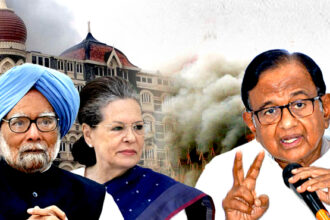On September 24, Leh, Ladakh, witnessed unprecedented violence in broad daylight. Angry protestors clashed with police, pelted stones, set a CRPF vehicle on fire, and even torched the BJP office along with the Hill Council building. What appeared to be a movement for statehood and inclusion under the Sixth Schedule of the Constitution quickly turned violent, raising questions about who was truly behind the unrest.
Reports suggest that so-called climate activist Sonam Wangchuk — celebrated by the media as the “real-life Phunsuk Wangdu” of 3 Idiots — along with some Congress councillors, played a crucial role in fueling this agitation.
From hunger strike to violence
For the past two weeks, Sonam Wangchuk had been on a hunger strike, demanding statehood for Ladakh and Sixth Schedule protections. But immediately after the violence erupted, Wangchuk released a video casually describing the unrest as a “GenZ Revolution, Arab Spring style.” Such framing raised eyebrows, as it seemed to trivialize and even justify the destruction.
Adding fuel to the fire were Congress councillors like Phuntsog Stanzin Tsepag, who was reportedly present in the mob and accused of inciting violence. Police invoked Section 163 of BNSS 2023, which prohibits unlawful assembly of more than five people without permission. Tsepag’s speeches and social media posts are now under investigation for provoking communal discord. His controversial past — including a 2020 arrest for creating obscene fake profiles — further taints his credibility.
Another Congress councillor, Smanla Dorjey Norbu, was caught on video openly challenging the administration. He declared that even heavy deployment of security forces would not stop protestors from storming the BJP office. He went as far as urging people across Ladakh to march to Leh on September 24 — exactly what unfolded.
Ironically, the very same night, Wangchuk abruptly ended his 15-day hunger strike, raising the question: was the strike merely a tactic to mobilize youth against the government, only to exit once violence had served its purpose?
The strategic dimension of Ladakh
Some argue that the demand for statehood and Sixth Schedule inclusion is a local rights issue. But Ladakh is no ordinary territory — it is India’s strategic backbone against Chinese aggression. Handing greater administrative autonomy at a time when border tensions are intensifying could weaken India’s firm stance against Beijing.
History offers lessons. Despite having an elected government, Jammu and Kashmir remained plagued by militancy until direct central intervention brought relative peace. Ladakh was carved out precisely to address grievances of administrative neglect. With Article 370 gone, and Ladakh given direct Union Territory status, the argument of discrimination no longer holds.
Moreover, the Union Government has already initiated significant measures: raising ST quota from 45% to 84%, reserving 33% seats for women in local councils, recognizing Bhoti and Purgi as official languages, and creating 1,800 new government jobs. In fact, fresh dialogue with Ladakh leaders was scheduled for September 25–26, with another round on October 6. Why then was violence triggered just a day before talks?
The Home Ministry’s late-night statement directly blamed Sonam Wangchuk for failing to calm protestors and instead exiting the scene, leaving chaos behind.
The foreign-funded “activist”
To see Wangchuk merely as a climate activist would be misleading. His background is deeply controversial. His father was a Congress minister in Jammu & Kashmir. Since founding the Students’ Educational and Cultural Movement of Ladakh in 1988, most of his projects have been bankrolled by Western organizations like the Ford Foundation, Tata Trust, Rockefeller, Soros-linked networks, and others.
His wife, Rebecca Norman, an American educated at Harvard, has long associations with U.S.-based foundations. From 2002 onwards, Wangchuk received fellowships from Ashoka, Skoll, Schwab, and Rockefeller networks. In 2018, he was awarded the Ramon Magsaysay Award — another prize often tied to Western funding networks.
During the UPA era, he was invited to help shape Leh Hill Council policies and even joined the National Council of Education. Around the same time, the Congress signed its controversial MoU with the Chinese Communist Party in 2008.
Interestingly, Wangchuk once supported the abrogation of Article 370 but later turned into a critic, with his rhetoric being amplified by Pakistani media. He even traveled to Islamabad for a “Breathe Pakistan” environmental conference, where he lauded Pakistan’s environmental efforts while downplaying India’s.
Western media has celebrated his “Ice Stupa” project, but many Ladakhi locals have questioned its practicality. Politically, he has not hidden his hostility toward the Modi government — at one point comparing BJP’s handling of Ladakh to “Ram rescuing Sita from Ravan only to sell her in the marketplace.”
Protest or political theatre?
The pattern becomes clearer:
- Violence erupts on September 24.
- Two Congress councillors are caught inciting protestors.
- Sonam Wangchuk casually brands the violence a “GenZ revolution.”
- The same evening, he abruptly ends his hunger strike.
The timing strongly suggests that the so-called agitation was not about Ladakh’s genuine concerns but about manufacturing unrest and pressuring the government.
The larger question
So, whose fight is Ladakh’s? Is it truly about development and local rights, or is it about foreign-funded activism, Congress’s politics, and destabilizing India’s most sensitive border region?
Ladakh is India’s frontline against China. Any unrest here directly benefits forces hostile to India. By fueling discontent, glorifying violence, and aligning with questionable political actors, Wangchuk and his allies risk turning a genuine dialogue into an orchestrated agenda.
The people of Ladakh deserve answers. And the nation must ask: Is this truly a grassroots movement, or yet another “toolkit revolution” disguised as activism?






